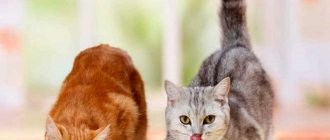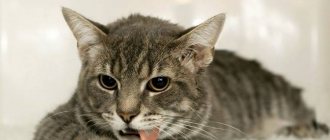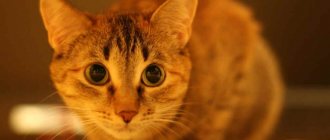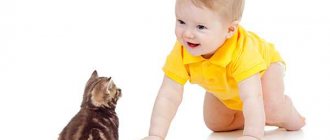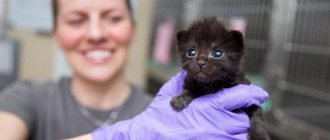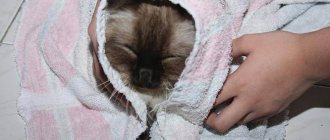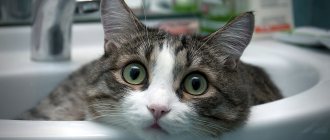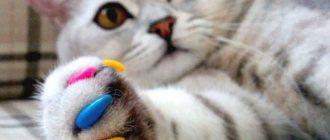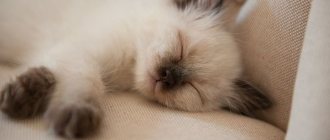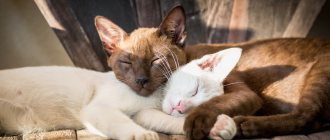Any rehabilitation of a cat after intestinal surgery includes correction of daily nutrition. It is also often difficult for owners to feed a cat that has recently suffered from stomach and other diseases. If your pet does not eat for several days, while its general condition worsens and other pathological symptoms are recorded, then you should immediately contact a veterinarian for help. To maintain the normal condition of a cat during illness, it is possible to feed it liquid food from a syringe and give it water in the same way.
Loss of appetite due to illness and other reasons
Situations often arise when cats refuse to eat and drink.
Sometimes owners feed their pets monotonous food, which bores them. As a result, they cannot get the cat to eat. But there are cases when the cause of an animal’s lack of appetite is illness.
In this case, it is important to correctly diagnose the disease and treat it in time.
The main reasons why a cat stops eating:
- Nervous feelings. Due to stressful situations, animals cannot eat normally. A disorder of their nervous system may occur due to moving to a new place, a long journey, the appearance of new animals in the house, the birth of a child, lack of attention, or a long absence of the owner of the house.
- Changes in the usual home environment . For example, moving a bowl or tray to a new place that is unusual for him, replacing an old plate or bowl of water with another container.
- Poisoning. In case of an eating disorder, in addition to a lack of appetite, the animal experiences nausea and vomiting, liquid bowel movements, general weakness of the body, loss of interest in games, and constant drowsiness. If your pet's condition does not improve within a few days, he will begin to lose weight. It is important to take him to the vet.
- Diseases. Infections, inflammatory processes, the development of various tumors, chronic renal failure, problems with the liver, intestines or stomach, as well as diseases of the oral cavity can cause loss of appetite. If the cat appears to be a healthy animal outwardly, but eats very poorly, it is better to take it to a veterinary clinic to rule out the listed diseases;
- Other reasons. A cat’s appetite may deteriorate due to a change in season, during the period of estrus, strong changes in weather, etc.
It is necessary to worry about a cat’s loss of appetite if the situation is aggravated by the appearance of nausea, vomiting, and lethargy. It is important not to miss a serious illness and provide timely assistance to your pet.
Combine a new diet with an old one
The classic way to do this is to start mixing old food with new food. This can be a dry diet, a wet diet, or a combination of both.
The basic principle of this scheme is this: on the first day you mix the new food with the old. 10% of the food in the bowl is new food, 90% is familiar.
On the second day you add up to 20% new food. And so on, increasing new food by 10% every day. Eventually, your cat should be completely on a medicated diet.
The process of transitioning to a new diet may stop. Let's say your cat eats food in a 50/50 ratio and doesn't finish it when you increase the portion of the new food. In this case, stay a little longer at a ratio that is acceptable for your cat. Then try again to increase the portion of the new food.
This method works for many cats.
Your pet should not go hungry, so offer him two bowls of food. One with a mixture of new and old food, the second with old.
If the cat turns away from the first bowl, it can eat its familiar food.
Then, every day, slowly reduce the amount of the usual food until it is not enough to completely satiate. This will keep the cat interested in the new food. She will need time to get used to the new texture, smell and taste.
Some cats may not like the idea of mixing different foods in one bowl. Then abandon this method and place the medicinal food next to the usual one. Then proceed according to the same scheme: gradually reduce the amount of old food.
Never starve a cat: it does more harm than good. Let her eat something rather than nothing.
5 weight stages
An animal’s weight can tell you a lot: health status, rate of development, etc.
Be sure to read:
Food for sphinxes, what to feed a kitten and an adult cat: menu by month
There are 5 stages of physical fitness in a cat:
If your pet is at the stage of exhaustion, overweight or obesity, urgent consultation with a veterinarian and nutritional correction is necessary!
Advice! To find out your pet's weight, weigh yourself on a bathroom scale. Then weigh yourself. Subtract your own from the total weight and find out how much your pet weighs.
Force feeding rules
Before force-feeding, it is important to ensure that such actions will not harm the animal.
The rules for force feeding are as follows:
- If the cat can lift its head, offer it liquid food. Place the food on a saucer or let it lick it off your finger. Try to encourage the animal to eat with your actions.
- Make a ball out of the pate , place it in the animal's mouth and stroke the throat to provoke the swallowing process.
- Milk or other liquid food can be given to your pet from a syringe. To do this, it is recommended to use a 2-5 ml syringe without a needle with the plastic tip removed.
- If the cat has closed its mouth tightly, try to force it open slightly , and squeeze out the food itself as close to the root of the tongue as possible.
- If the cat's body is too weakened, force feeding is carried out using a probe , which is inserted into the nasopharynx. The tip of the probe is passed to the stomach, and liquid food is injected into the animal’s stomach through a tube using a syringe.
When force-feeding, the cat's body is supported by droppers with vitamins and other useful substances.
Features of syringe feeding
Buy a medical syringe and cut the nose with scissors. Fill the syringe with the prepared food, which should be squeezed directly into the cat’s mouth.
Feeding a cat with a syringe
Try to push it into the gap between your teeth, squeezing the food out of your cheek. When feeding this way, raise your pet's muzzle a little.
Features of feeding a cat with a syringe:
- pour food in small portions so that the animal has time to swallow it;
- make sure that food does not get into your pet’s windpipe;
- squeeze out the food when the cat exhales, and when inhaling, stop the food supply;
- If your cat is choking on food, give her time to clear her throat and calm down, then continue syringe feeding.
Thus, the cat should be fed in small portions several times a day.
Force feeding a newborn kitten
The best product for feeding a newborn kitten is a special mixture that can be purchased at a veterinary pharmacy. She will notice the cat's milk to the pet.
Be sure to read:
Development of kittens by weeks and months: how they grow, look, until what age is considered a kitten
If it is not possible to purchase food, you can prepare it yourself, for example, by diluting baby dry formula in water twice as thin as indicated in the instructions.
Place the prepared food in a bottle with a nipple, pipette or syringe
Place the prepared food in a bottle with a nipple, pipette or syringe. Feed the kitten slowly so that it has time to swallow the food. When force-feeding, hold the baby in an upright position by inserting a syringe or pipette into the cheek.
Calculation of the mixture in the first 1–4 days – 30 ml per 100 g of weight per day. The kitten should gain 15 g of weight per day. After seven days, the pet’s weight should be twice as much as at birth.
What to feed a sick cat
To quickly restore the strength of a cat with poor appetite, you need to follow a special diet . On the recommendation of a veterinarian, you can purchase special medicinal ready-made food. For pets who refuse to eat due to illness, there are liquid foods.
Such food has a pleasant aroma and taste, which stimulates the animal’s appetite. A small portion of this food contains the amount of nutrients that a pet needs for a day. The product is quite high in calories, so the cat quickly becomes full.
To quickly restore the strength of a cat with poor appetite, you need to follow a special diet.
The animal can also be fed lean meat, such as chicken with broth. Poultry can be replaced with beef, rabbit or liver.
The cat will also like fish broth. The diet of a sick pet should include egg whites, cottage cheese and milk. But if the cat is poisoned or has problems with the gastrointestinal tract, dairy products can be given only after the doctor’s permission.
What to feed an adult cat if she refuses to eat
For an adult cat with poor appetite, it is recommended to prepare dishes from sea fish, intestines, liver, spleen, cow brain or other animals. You can give low-fat cottage cheese, kefir, beef, lamb, fish, vegetables.
All products are cut into small pieces so that the pet can chew them, massaging the gums. It is not recommended to give cereals and baked goods, as such products disrupt the intestinal microflora.
If necessary, the veterinarian can prescribe medications - appetite stimulants.
What to feed an adult cat with poor appetite
To improve your cat's appetite, you can feed your cat not only homemade food, but also commercial food recommended by a veterinarian. The doctor may also prescribe taking vitamin complexes for appetite.
Be sure to read:
When to start feeding kittens: how to introduce them, diet, what not to feed, age for first feeding
Any dish should be given to your pet warm, cut into small pieces or in liquid form.
Important! The cat must have constant access to fresh water and food.
Why does my pet refuse to eat?
When a kitten or adult is sick, the protective mechanisms of the immune system are reduced and the pet often refuses to feed. This reaction is normal for a weakened cat’s body, and owners should not worry too much or force-feed a sick cat. Usually the problem occurs in the first few days after an infection enters the animal’s body and another disease develops. After 2-3 days, the cat may ask for food on its own, or you should try to force-feed it with a small amount of food.
Veterinarians do not recommend allowing prolonged fasting during and after a cat’s illness, since the pet’s strength rapidly decreases and it is more difficult for the sick body to recover.
In most cases, the problem is associated with diseases of the gastrointestinal tract. The treatment process, during which the cat is given various drugs that reduce appetite, can affect impaired feeding. The reason may also be due to other factors:
A stressful state affects the animal's appetite.
- getting a foreign object into the throat or esophagus, which the pet cannot get rid of on its own;
- body bruise of varying severity;
- poisoning of the body;
- impact of stress.
Reasons for refusing water
To restore your cat's interest in water, change the bowl first.
If your cat won't drink water from his bowl, he may not like the dishes, or he may be drinking from a toilet, dripping faucet, bucket, or other kitchen container.
Psychological reasons for refusing water:
- uncomfortable bowl;
- there is stagnant water in the drinking bowl;
- food from a nearby bowl got into the liquid;
- after playing with water she became dirty.
Having identified the reason for refusing water, it is important to eliminate it.
Make food more attractive
Delicious protein
Mix in tuna or chicken to improve the flavor of the food. But be sure to consult a veterinarian, because... In some diseases, high-protein foods can be harmful.
Take canned tuna in a jar. Tuna in water/its own juice will do. Do not use canned foods with oil. Take water from a jar and pour it over your food. Most cats love the taste of tuna and this makes them more willing to accept new food.
Probiotics
A probiotic supplement also attracts cats to eat. It is acceptable for most health conditions. This supplement is a probiotic powder, hydrolyzed protein. It is usually used for bloating or food allergies. Cats quite like the taste of this supplement.
Veterinary drugs
There are medications and veterinary medications to improve appetite.
Always consult your veterinarian before making any dietary changes.
How to make a cat drink
To restore your cat's interest in water, first change the bowl . Animals usually prefer a bucket, pan, or vase. You can place different containers of water in different places.
You can add a little milk or broth to clean water. But such a drink should be changed often, as it quickly deteriorates, especially in a hot room.
You can offer your cat to drink water from the tap or install a special drinking fountain.
If the recommendations listed do not help, the cat must be force-fed using a syringe. This method is also often used for stress or toothache.
Give your cat a choice
Cats care not only about the taste, but also about the texture of their food.
Unfortunately, the range of flavors and textures available in veterinary diets is limited. However, in many cases there are several brands to choose from. Sometimes the manufacturer offers one diet in different versions: dry, pouch, canned.
Ask your veterinarian about alternatives to the food he or she prescribes.
Tip 1: Look for food in small packages, it’s more profitable to try different diets.
Tip 2: On classifieds sites and social media. In networks you can find animal owners giving away leftover medicinal food for free. This way, you will have the opportunity to “test” the diet without having to spend extra money. But make sure that the product is fresh and has a good shelf life.

